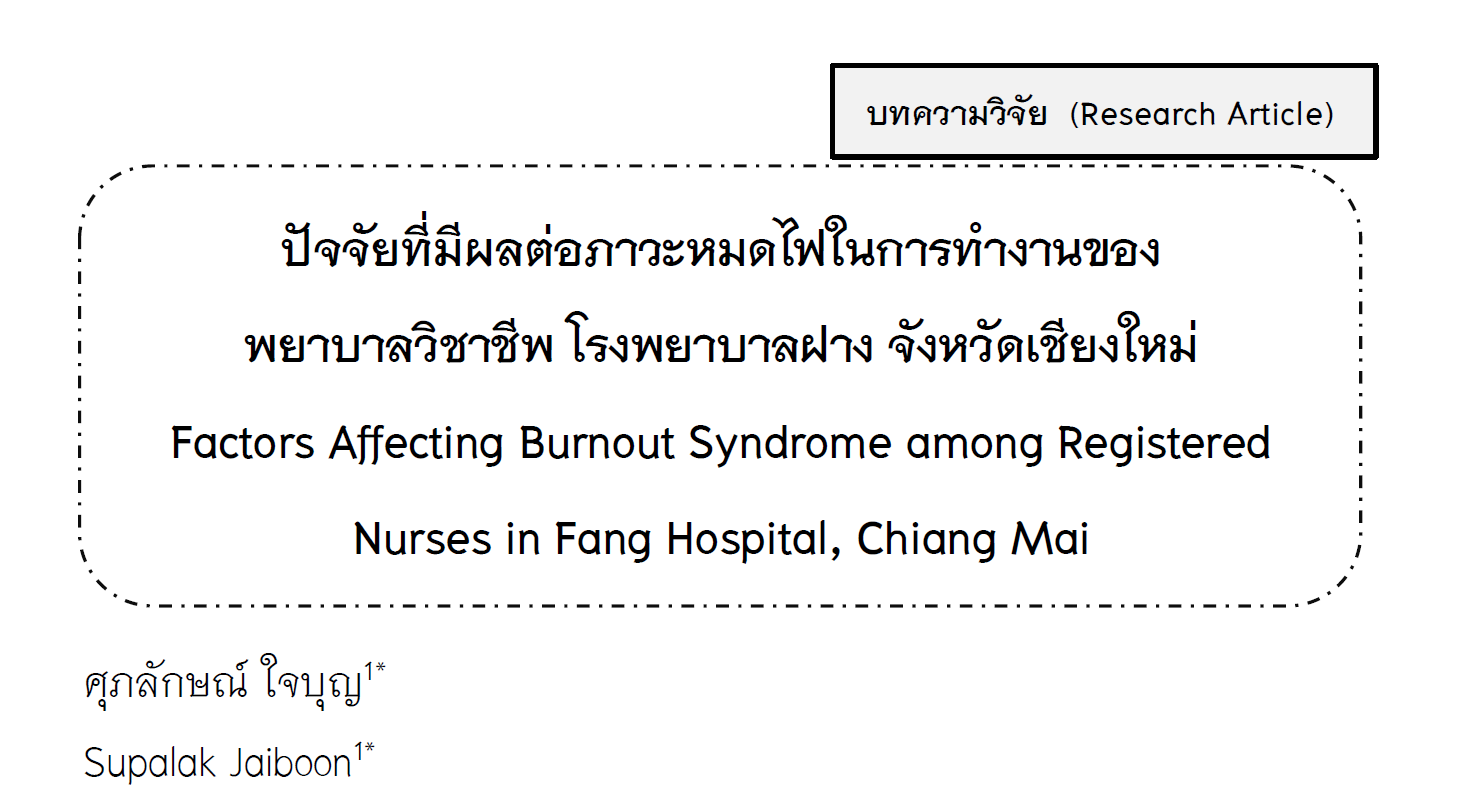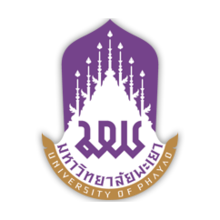Factors Affecting Burnout Syndrome among Registered Nurses in Fang Hospital, Chiang Mai
Keywords:
Burnout syndrome, Factors affecting burnout syndrome, Registered nurseAbstract
This cross-sectional descriptive study, aimed to investigate the prevalence and predictors of burnout syndrome among registered nurses at Fang Hospital, Chiang Mai Province. A sample of 115 registered nurses was selected using a stratified random sampling method. Data were collected using validated instrument, including the workload questionnaires, resilience questionnaires, quality of work life questionnaire, and burnout syndrome questionnaire. Descriptive statistics and multiple logistic regression analysis were used for analysis.
The results revealed that most participants were female (94.80%), aged 20–30 years (40.90%) and had 1–5 years of work experience in the hospitals (39.10%). Burnout syndrome was identified in 38.30% of the participants. In terms of burnout dimensions, 37.40% reported a high level of emotional exhaustion, 67.80% experienced a low level of depersonalization and 95.70 % had a low level of personal accomplishment. Multiple logistic regression analysis identified significant predictors of burnout syndrome, including a high or very high workload (adjusted OR=4.73, 95%CI:1.45-15.46) and low quality of work-life, particularly in work-life balance (adjusted OR=5.79, 95%CI:1.59-21.14).
The findings highlight the importance of managing nursing workforce levels and workload appropriately, as well as enhancing the quality of working life for particularly in achieving work-life balance. Such measures could reduce burnout and improve workplace and working efficiency.
References
กชามาส วิชัยดิษฐ, อารยา ประเสริฐชัย และปกกมล เหล่ารักษาวงษ์. (2565). ภาวะหมดไฟในการทำงานของบุคลากรทางการแพทย์ โรงพยาบาลรัฐ ในจังหวัดชุมพร. วารสารสุขภาพจิตแห่งประเทศไทย, 30(3), 211-21.
กรมสุขภาพจิต กระทรวงสาธารณสุข. (2023). ข้อมูลการประเมินสุขภาพจิตคนไทย. สืบค้น 8 เมษายน 2566, จาก https://checkin.dmh.go.th/.
กรมสุขภาพจิต กระทรวงสาธารณสุข. (2564). เปลี่ยนร้ายกลายเป็นดี (พิมพ์ครั้งที่ 4). กรุงเทพฯ: บริษัท บียอนด์ พับลิสชิ่ง จำกัด.
โรงพยาบาลฝาง. (2566). งานบริหารและพัฒนาทรัพยากรบุคคล. เชียงใหม่.
โรงพยาบาลฝาง. (2566). งานสารสนเทศทางการแพทย์. เชียงใหม่.
ณัฐนันท์ ฤทธิ์สำเร็จ, ธีระวุธ ธรรมกุล และ ปกกมล เหล่ารักษาวงษ์. (2565). ปัจจัยที่มีความสัมพันธ์กับภาวะหมดไฟในการทำงานของบุคลากรในโรงพยาบาลเอกชน อำเภอเมืองชลบุรี จังหวัดชลบุรี. วารสารสาธารณสุขมหาวิทยาลัยบูรพา, 17(1), 86-97.
นครินทร์ ชุนงาม. (2563). สุขภาพจิตและภาวะหมดไฟในการทำงานของแพทย์ในโรงพยาบาลทั่วไปและโรงพยาบาลชุมชน จังหวัดนครราชสีมา. วารสารสุขภาพจิตแห่งประเทศไทย, 28(4), 348-59.
นันทาวดี วรวสุวัส. (2563).การพัฒนารูปแบบการเสริมสร้างภูมิคุ้มกันทางใจเพื่อป้องกันภาวะหมดไฟในการทำงานของเจ้าหน้าที่สาธารณสุข เขตสุขภาพที่ 7. วารสารวิจัยและพัฒนาระบบสุขภาพ, 13(2), 603-13.
ปิยะวดี สุมาลัย. (2564). ภาวะหมดไฟในการทำงานของพยาบาลวิชาชีพ สถาบันบำราศนราดูร.วารสารวิทยาลัยพยาบาลพระจอมเกล้า จังหวัดเพชรบุรี, 4(2), 66-78.
พัชราภรณ์ สิณัตพัฒนะศุข และธนาสิทธิ์ วิจิตราพันธ์. (2565). ปัจจัยเสี่ยงของภาวะหมดไฟในการทำงานของบุคลากรโรงพยาบาลสันป่าตอง จังหวัดเชียงใหม่. วารสารวิชาการสาธารณสุข, 31(1), 154–163.
วัลลภ วิชาญเจริญสุข และสุนทร ศุภพงษ์. (2558). ภาวะหมดไฟในการทำงานและปัจจัยที่เกี่ยวข้องในผู้แทนยาบริษัทยาข้ามชาติ. ธรรมศาสตร์เวชสาร, 15(2), 225-31.
ศิวัช ธำรงวิศว, จารุรินทร์ ปิตาพงศ์ และวิศรุต ศรีสินทร. (2562). ความเหนื่อยล้าจากการทำงานและปัจจัยที่เกี่ยวข้องในพยาบาลวิชาชีพโรงพยาบาลสงขลานครินทร์. เวชสารแพทย์ทหารบก, 72(3), 177-85.
ศรีสกุล เฉียบแหลม และ เพ็ญนภา แดงด้อมยุทธ์. (2562). ภาวะหมดไฟในการทำงาน. แพทยสารทหารอากาศ, 65(2), 44-52.
สุปรียา สัมฤทธิ์วงค์, นิตยา เพ็ญศิรินภา และพรทิพย์ กีระพงษ์. (2565). ปัจจัยที่มีผลต่อภาวะหมดไฟในการทำงานของพยาบาลวิชาชีพโรงพยาบาลนครปฐม. วารสารวิทยาลัยพยาบาลพระจอมเกล้า จังหวัดเพชรบุรี, 5(3), 83-97.
สสิพรรธน์ นิลสงวนเดชะ. (2558). ภาวะเหนื่อยหน่ายในการทำงานและกลวิธีในการเผชิญปัญหาของพนักงานองค์การเภสัชกรรม. (วิทยานิพนธ์ปริญญามหาบัณฑิต). กรุงเทพฯ: จุฬาลงกรณ์มหาวิทยาลัย.
เสาวลักษณ์ สระศรีสม. (2564). ภาระงานที่ส่งผลต่อความพึงพอใจในงานของบุคลากรกองคลัง องค์กรปกครองส่วนท้องถิ่นจังหวัดกาญจนบุรี. (วิทยานิพนธ์ปริญญามหาบัณฑิต). กรุงเทพฯ: มหาวิทยาลัยศิลปกร.
ANA Nursing Resources Hub. (2024). Nurse burnout: What is nurse burnout? How to prevent it. Retrieved Mar 17, 2023, from https://www.nursingworld.org/content-hub/resources/workplace/what-is-nurse-burnout-how-to-prevent-it.
Borges, M. M. S., Nunes, V. R., Pires, M. P., Lima, B. G., Hipólito, U. V., & Almeida, M. C. D. S. (2023). Quality of life at work and burnout in family health strategy workers. Rev Gaucha Enferm, 10(44).
Dall’Ora, C., Ball, J., Reinius, M., & Griffiths, P. (2022). Burnout in nursing: A theoretical review. Human Resources for Health, 18(41).
Daniel, W. W. (1995). Biostatistics: A foundation for analysis in the health sciences (6th ed.). John Wiley & Sons.
Cohen, J. (1969). Statistical power analysis for the behavioral sciences. Academic Press.
Gómez-Polo, C., Casado, A. M. M., & Montero, J. (2022). Burnout syndrome in dentists: Work-related factors. Journal of Dentistry, 121, 104143. https://doi.org/10.1016/j.jdent.2022.104143.
Gomez-Urquiza, J. L., Vargas, C., De la Fuente, E. I., Fernandez-Castillo, R., & Canadas-De la Fuente, G. A. (2017). Age as a risk factor for burnout syndrome in nursing professionals: A meta-analytic study. Research in Nursing & Health, 40(2), 99-110.
Luna, D., Figuerola-Escoto, R. P., Sienra-Monge, J. J. L., Hernández-Roque, A., Soria-Magaña, A., Hernández-Corral, S., & Toledano-Toledano, F. (2023). Burnout and its relationship with work engagement in healthcare professionals: A latent profile analysis approach. Healthcare (Basel, Switzerland), 11(23), 3042, form https://doi.org/10.3390/healthcare11233042.
Maslach, C., & Jackson, S. (1981). The measurement of experienced burnout. Journal of Organizational Behavior, 2(2), 99-113.
Maslach, C., & Jackson, S. (1982). Burnout in Health Professions: A Social Psychological Analysis. In G. S. Sanders, & J. Suls (Eds.), Social Psychology of Health and Illness (227-251). Hillsdale, NJ: Lawrence Erlbaum.
Maslach, C., Jackson, S.E. and Leiter, M.P. (1997). Maslach Burnout Inventory. In: Evaluating Stress: A Book of Resources (3rd ed), Scarecrow Education, Lanham, 191-218.
Shanafelt, T. D., Boone, S., Tan, L., Dyrbye, L. N., Sotile, W., Satele, D. and Oreskovich, M. R. (2012). Burnout and satisfaction with work-life balance among US physicians relative to the general US population. Archives of Internal Medicine, 172(18), 1377–1385, form https://doi.org/10.1001/archinternmed.2012.3199.
Sobczuk, P., Gawlik-Urban, A., Sigorski, D., Kiszka, J., Osmola, M., Machulska-Ciuraj, K. Brodziak, A. (2024). Prevalence and factors associated with professional burnout in Polish oncologists: Results of a nationwide survey. ESMO Open, 9(2), 102230, form https://doi.org/10.1016/j.esmoop.2023.102230.
Walton, R. E. (1973). Quality of working life: What is it?. Sloan Management Review, 15(1), 11-21.
World Health Organization. (2019). Burn-out an “occupational phenomenon”: International classification of diseases. Retrieved Mar 17, 2023, from https://www.who.int/news/item/28-05-2019-burn-out-an-occupational-phenomenon-international-classification-of-diseases.

Downloads
Published
How to Cite
Issue
Section
License
Copyright (c) 2024 Phayao University

This work is licensed under a Creative Commons Attribution-NonCommercial-NoDerivatives 4.0 International License.
ผู้นิพนธ์ต้องรับผิดชอบข้อความในบทนิพนธ์ของตน มหาวิทยาลัยพะเยาไม่จำเป็นต้องเห็นด้วยกับบทความที่ตีพิมพ์เสมอไป ผู้สนใจสามารถคัดลอก และนำไปใช้ได้ แต่จะต้องขออนุมัติเจ้าของ และได้รับการอนุมัติเป็นลายลักษณ์อักษรก่อน พร้อมกับมีการอ้างอิงและกล่าวคำขอบคุณให้ถูกต้องด้วย
The authors are themselves responsible for their contents. Signed articles may not always reflect the opinion of University of Phayao. The articles can be reproduced and reprinted, provided that permission is given by the authors and acknowledgement must be given.







